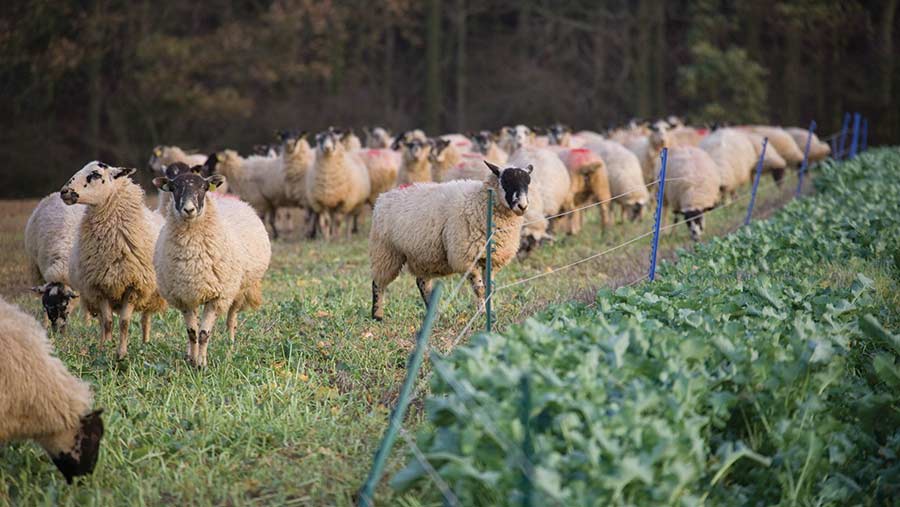All-grass wintering could save sheep farmers £15 a head
 ©Tim Scrivener
©Tim Scrivener Sheep farmers facing a massive reduction in profitability could maximise strong grass growth by strip grazing pasture through to lambing.
All-grass wintering (AGW), widely practised in New Zealand for decades, is saving sheep farmers from Scotland to Cornwall between £10 and £15 a head on wintering costs, SAC and AHDB monitor farms have shown.
See also: Guidance on implementing all grass wintering system in your flock
But soil type, drainage and pasture quality are all things to bear in mind when considering making the switch, with individual farmers having to “play it by ear” each winter, says John Vipond, sheep specialist with SAC Consulting.
“This is a good year to go into it, there’s a lot of grass about in good condition,” says Dr Vipond, who has mentored several flocks in the early stages of grass budgeting.
He insists that initial outlays, namely plate meters and sufficient electric fencing, are easily recouped by savings made in the first year, with winter grazing bringing the additional benefits of improved pastures and sheep temperament.
- Sheep dung and urine benefit perennial ryegrasses – a single urine patch contains 300kg of nitrogen/ha equivalent.
- Stones are buried and weeds and dead matter eaten.
- Sheep settle into shift patterns, choosing to lie down and rest rather than search for grass.
- Regular contact with other sheep makes them calmer and easier to handle.
Grazing residuals
As a rule, farms in a joint SAC and AHDB project left residuals of 1,000kg DM/ha, with some experimenting by leaving higher residuals of about 1,200kg post-scanning.
“One way is to start with 1,700kg DM/ha across the farm in the autumn in order to give it a start,” suggests Dr Vipond. “That will definitely see you though to scanning at least.
“Graze that down to about 900kg, allowing 800kg to be grazed. Sheep need about 1kg of grass a day, then 1.5kg a day after scanning.”
Nuffield scholar and grazier Mike Miller has experimented with AGW in the South West and is incorporating lessons learned from Nuffield travels to New Zealand.
He will be outwintering 500 New Zealand Suffolk cross Mules from mid-November at Mount Pleasant Farm, and is planning on building up a grass wedge of 2,500kg DM/ha and grazing 40ha of drier ground on four-day shifts, techniques regularly practised in New Zealand.
Mount Pleasant Farm, North Dorset
- 660 ewes, made up of 60 pedigree New Zealand Suffolks, 100 New Zealand Romneys and 500 New Zealand Suffolk cross Mules on 110ha of heavy clay pasture.
- Suckler herd of 40 cows is kept to maintain grazing quality for sheep.
- 500 sheep will be moved up to 40ha of drier land, of which 4ha is swedes.
- Rotational grazing managed with three lines of electric fencing.
- Residuals: newer pasture grazed down to 1,000kg DM/ha. Heavily thatched permanent pastures will be hit harder to 800kg DM/ha with daily shifts a possible option to increase grazing pressure.
“What I really took away from New Zealand was the growing of swedes and fodder beet and the skill of budgeting for winter,” says Mr Miller, who was impressed with the way all farm staff in Southland were able to calculate dry matter cover and winter feed budgets.
“We’ve got 4ha of swedes, which the ewes will go to for a month before they lamb at the end of March,” he explains. “This should be sufficient, growing about 12t DM but condensed into two months of the year when grass needs resting.”
Sward sticks and falling plate meters are a learning curve for many farmers, but Mr Miller insists gauging DM cover soon becomes second nature.
“I didn’t know anything about grass measuring when I started all-winter grazing schemes four years ago,” says Mr Miller. “If you’ve never done it before, winter is a good time to start – when grass is not growing as quickly. Eventually you learn to be able to gauge grass cover by eye.
“My average field size is about 2.83ha – ideal for rotational grazing.”
When to shift
Shifts can vary from 12 hours up to about four days, with pasture age and conditions dictating shift duration.
“My biggest mistake initially was overestimating the quality of the sward – it’s important to get sward assessment right,” warns Mr Miller, who has observed good results from pushing old leys harder and leaving higher residuals on newer, higher-production leys.
“Permanent pastures really do benefit from being pulled out hard. I’ve had 750 ewes on an acre, with flock pressure really getting to the bottom of the swards. Leaving higher residuals is really important for good spring grass growth and recovery, particularly for newer leys,” he adds.
Limitations
- Larger flocks suit strip grazing through the winter for AGW and extended wintering systems. SAC and AHDB suggest a minimum flock size of 250-300.
- Stewardship limits winter grazing in some areas.
- Be wary of poaching issues due to wet land and soil type.
- Farms further north or at greater altitude will probably need to include housing. Introduce concentrates, building up sheep to 0.45kg (1lb) a day to switch to a housed diet.
Top tips
- Stock sheep at high stocking rates – 400-1,000/ha on small paddocks.
- Assess DM and budget for feed.
- Graze older pastures harder. This will promote growth from rye grasses and clover.
- Revisit pastures in a mild winter, if necessary.
- Budget for 100 days winter grazing.
- Put aside sacrifice land for hard times – enough forage for two weeks.
- Dry ewes require 1kg of grass a day, requiring 2% of body weight of grass up to scanning, increasing to 3% when mothering lambs.
- Avoid disturbance by erecting fences ahead of sheep and not fencing adjacent to grazing ewes if possible.
In winter, grass length typically means:
- 5cm = 1,500kg DM/ha
- 9cm = 2,100 kg DM/ha
